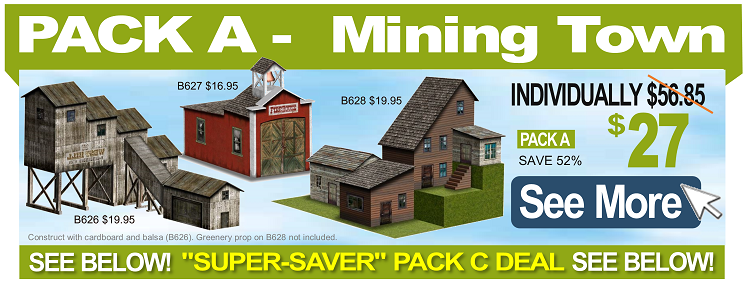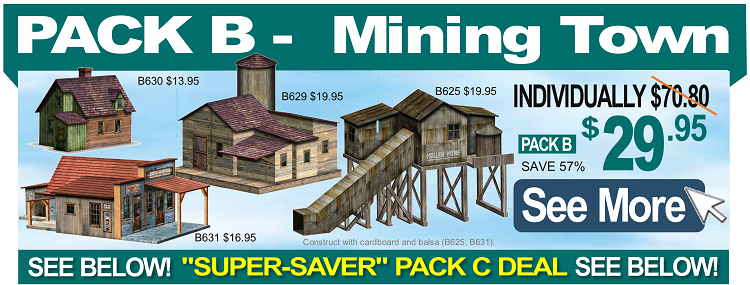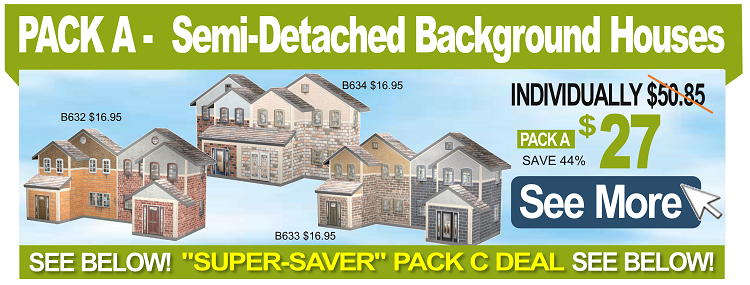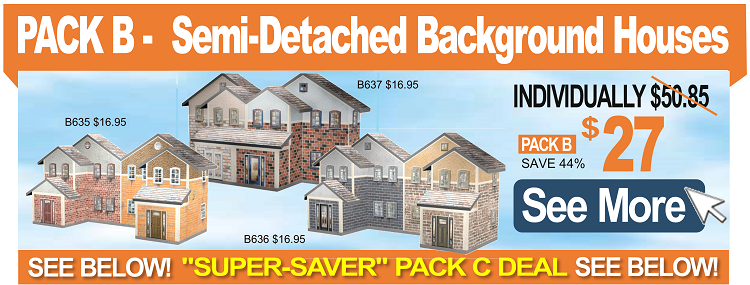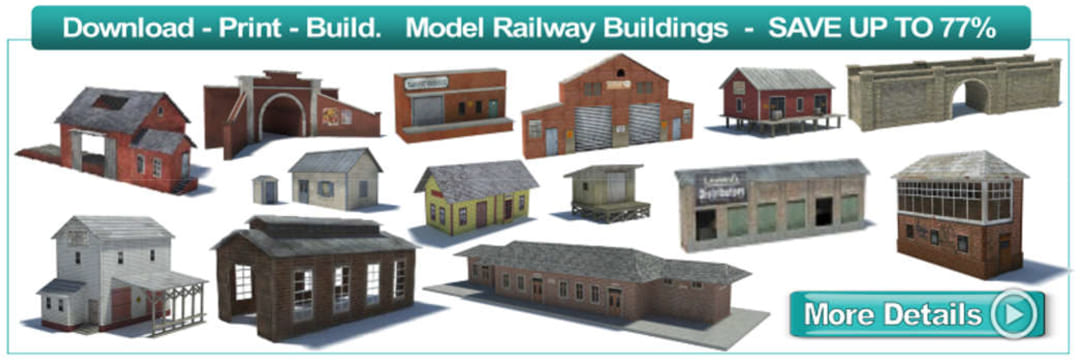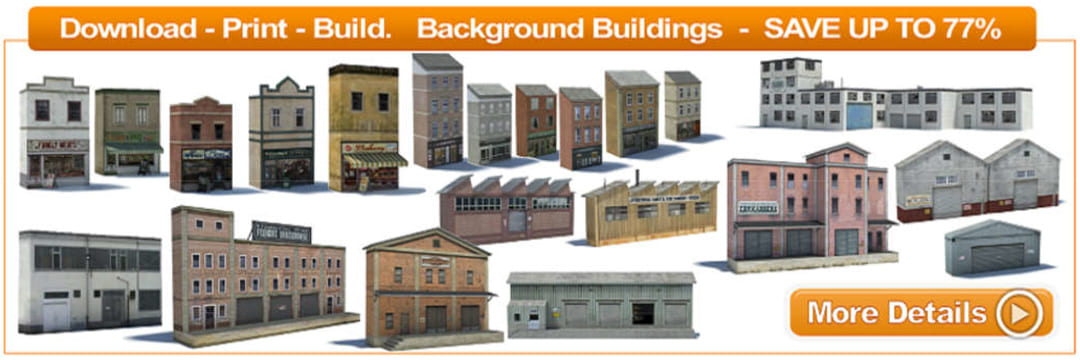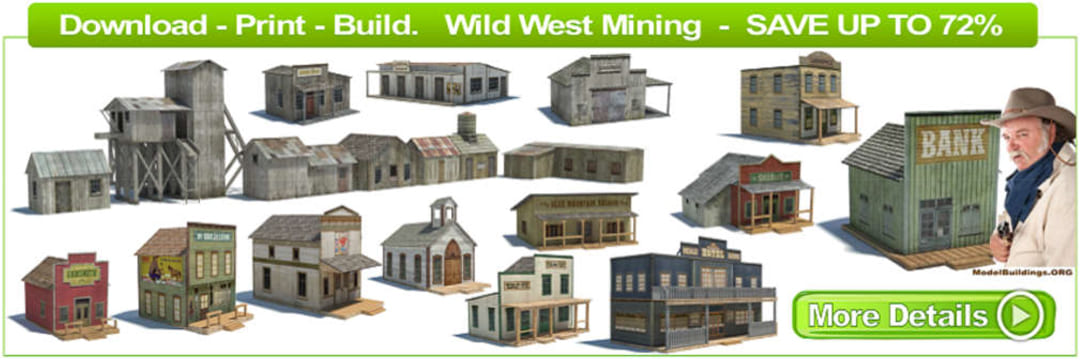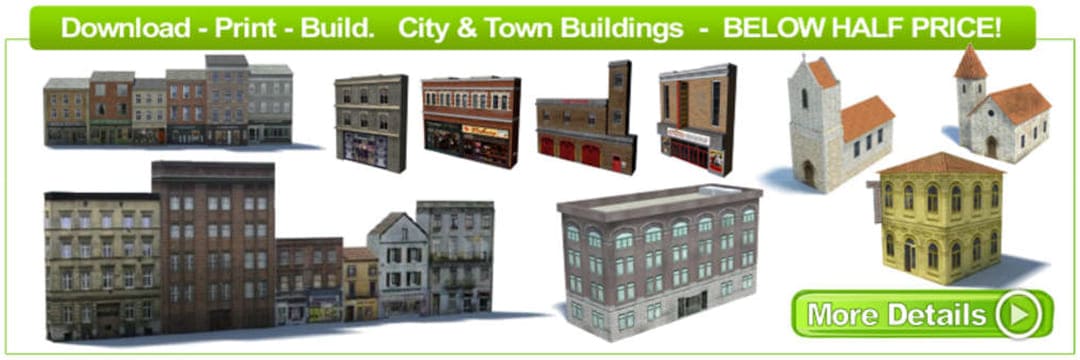200+ Wonderfully Realistic Model Railway Train Buildings
Download, Print, and Construct. Excellent for
HO Scale, N Scale, and OO Gauge Train Layouts
Download Your FREE CATALOG
of model train buildings from Our Home Page
If you are fascinated by model trains, or just enjoy creating layout scenery and structures, then this structure building website is for you. It not only has a huge range of more than 200 printable HO, N, and OO scale model railway buildings, but it also features helpful construction videos, free scale train calculators, and free train room signs for railway modelers. You’ll find details of the full range of printable model train buildings as downloads, and video assembly demonstrations etc., are on the HOME PAGE.
Download These Accurately Designed, Authentically Detailed,
Printable Scale Model Railway Buildings For Your Train Layout
For a train layout to look real and convincing to the eye, railroaders know that attention to the smallest detail is what can differentiate an ordinary train layout from one of those masterpieces on display at major train shows or railway exhibitions. Attention to detail is not limited to the precision of the engines, cars and other rolling stock, it is also about creating convincingly realistic miniature scenery for the rail line to pass through. OO gauge, N scale, and HO scale trains operating on a flat baseboard without the accompaniment of “real looking” scenery, model train buildings, and architecture will just look like toy trains, as opposed to miniature scale replicas of full size trains.
This process not only involves replicating real life natural occurrences like hills, mountains, streams, cliffs, trees and other foliage, the sky and clouds etc., but also the human-made structures and elements likely to be found in and around a town, farm, port, industry, or rail yard scene or railway track. Manufactured elements, objects, structures, and model train buildings on a scale railroad need to portray a likeness to their real life counterparts.
Anything that is a scaled down copy of full sized object will fit into that category including: road and rail bridges, brick walls, houses, telephone poles, fences, vehicles, shops and retail stores, industrial structures like warehouses, factories, silos, loading docks, freight depots, signals, train tracks, station platforms, and the list goes on. Having just one, or a couple of these man-made objects out of place, or presented in an artificial manner, can spoil the whole scenery effect and give the game away.
Imagine viewing a layout at a train show, and becoming absorbed in the imagery and story of a 1930’s railroading scene, only to spot a 1950’s vehicle parked in a side road. The whole fantasy of being engrossed in the miniature scene (as if it where a real life scene), suddenly disappears and seems unreal. This is precisely why we have put so much effort into making the model railway buildings available on this website so true to life and accurate in detail.
Complete Your Railway Backdrop With Characterful “Life-Like” Model Train Buildings
Once you download, print and build you will iimmediately come to realize the incredible flexibility that you can get out of these scale model railway buildings. No matter if you aim for creating a freight dept or a church, a shop, train station, or bus shelters, you won’t be disappointed with the quality, realism, and durability of the assembled structures you buy.
There is nothing more rewarding than being able to construct these impressive OO, N, or HO scale model train buildings on your own. Simply by working from the simple to follow instructions, you will get guaranteed wonderful results in no time. You will be able to download the plans you wish to create and (if you choose), use the same image templates as many times as you want. This enables you to save money by making duplicate buildings, or extending the designs to enlarge the model structures.
Recreate a Miniaturized Old Wild Western or Mining Town
with theseCompletely Authentic Scale Model Railway Buildings
The hands-on world of a scale railroader is indeed a special experience. Bring your sense of wonder with you… as your hobby takes you on a fascinating journey… where you’ll learn how to get started in this enthralling hobby.
The hands-on world of a scale railroader is indeed a special experience. Bring your sense of wonder with you… as your hobby takes you on a fascinating journey… where you’ll learn how to get started in this enthralling hobby.
Railway modeling is often called “the world’s greatest hobby.” Some might consider this to be self-promotion, but if you consider the breadth of skills and interests that this hobby encompasses, there is a good deal of support for that position. If you ask train enthusiasts “what appeals about the hobby?” you’ll get a variety of answers. For some, it is a way of re-creating a fond childhood memory.
Others; simply enjoy building a world in miniature with all its detail and realism. Then there are those train railroaders who love solving the technical problems of building and operating an electronic control system.
Scale modeling includes areas of technical, artistic, historic and manual skills, as well as a great potential for club and group interaction. Yet, on some level, it is always a solitary hobby as well. Personal expression and storytelling are usually prominently displayed, and train layouts are built by everyone from the very young to the very old.
Investigating this hobby might just start you on a lifelong journey from the past to the future of one of the first forms of mechanical transportation. Even today, new technology changes the face of railroading quickly, and trains will always be there to let you enjoy re-creating each advance in miniature.
Building a model railway layout and operating model trains is an excellent hobby and can be as expensive, or as inexpensive, as you want to make it. If you want the full enjoyment of this enthralling hobby over many years, then be prepared to fork out a lot of money. If model railroading gives you a lot of pleasure and satisfaction, then it is well worth it.
However, what you invest is entirely over to you. If you’re looking for something simple, then you can stick with a cheaper brand. It’s basically up to you. Just make sure that you know what you want and price out any purchase carefully.
You can also save a lot of money, time, and frustration by minimizing or eliminating mistakes. Learn as much as you can from experienced people in the hobby, and use the online resources available to you… and never stop learning! There are also ways to save money, such as constructing model train buildings from card, corflute, or balsa wood instead of buying plastic kits which can be very expensive, and you still need to paint them and have the skills to weather and detail them to a high standard so as to remove the appearance of being painted plastic models. That’s not to say plastic kits are not worthwhile, they certainly can be impressive if you have the budget and required airbrushing skills to bring them to life. Printable paper model railway buildings have the advantage being downloaded in full color complete with photographic style images showing the type of precise details likely to be found on real structures e.g. Downpipes, rusty metal, flaky painted timber, water marks and stains etc.
City and Town Model Train Buildings to Create a Busy Urban Street Scene
for HO Scale, OO Gauge, or N scale Train Layouts or Scenery Dioramas
To resemble the real world, model trains shouldn’t run in isolation on a flat baseboard without scenery and structures to help tell the story of why the trains are there. That’s where scenery props like hills and mountains, roads and bridges, vegetation and streams, can help complete the scene that is being replicated in miniature. Trains are a form of transport so in real life travel from one destination to another delivering cargo and freight, or passengers from one railway station to another, or from one rail yard to another in the case of freight. Neither the trains, or the scenery work in isolation without human activity incorporated into the scene to give it the appearance of being active and alive, rather than resembling a deserted landscape or urban setting. So plastic people (and animal) figures, and vehicles will add life to a model train layout. So too, will model railway buildings which also give people and trains a reason for being part of the scene. This is where these downloaded printable paper models can be so effective in producing genuine looking replica model structures for a very reasonable price. Have a look through the catalog on the Home Page for the huge range of plans available in OO gauge / HO scale, and also in N scale.
[expander_maker id=”1″ more=”Load more” less=”Load less”]
Constructing Miniature Scenery and Photo-Realistic Model Train Buildings
is a Fun and Absorbing Aspect of this Wonderful Hobby
Rail modeling is an absorbing leisure-time activity that provides plenty of creative opportunities and interesting projects of a technical nature. It incorporates a variety of interesting activities from constructing, maintaining, upgrading and operating a train set whether it is OO gauge (UK measurement), N scale, or HO scale. What kind of world you create, where you create it, and how much time you spend in it…. is entirely over to you.
You can build a model train layout in the solitude of your basement, attic, shed or garage workshop…or you can sit in a sun lounger and watch trains weave around your garden… or you can join a local railroading train club and share your ideas and experiences with others. The opportunities are endless!
Yes! Rail modeling is a great way to meet people and make friends. There are numerous clubs you can join where you can meet with all types of people who share a similar interest for trains. You’ll have the opportunity to share ideas, get advice from experienced hobbyists, attend conventions, build a train layout or model railway buildings and scenery as a group project, and even take train trips together. This is a truly wonderful hobby because:
- You’ll pickup valuable skills in: artistic painting, construction and carpentry, electrical wiring, problem solving and design.
- You’ll discover creative opportunities that will bring to the fore your hidden talents when building scenery.
- Gain experience building railway models from printable paper plans.
- You’ll develop an in-depth knowledge of geography when designing and making landscapes.
- You’ll step back in time and learn how things operated in bygone days.
- You’ll gain some engineering skills when designing your layout to make it fit, build your bench-work so it won’t fall apart, or examine how a level crossing operates, or a bridge is built, or how to create an efficient shunting yard.
- You’ll enjoy the challenge of constructing realistic miniature replicas of life and scenes from history.
You don’t have to be a millionaire, or a technical genius, or a brilliant artist to be part of this world. The single most important skill you will require is patience. If you have plenty of patience, then you will thrive in this environment.
The scale you choose to model in will depend on what you want from a layout and the space you have available. You may want to see long trains running quickly through a town or countryside scene, or perhaps you would prefer a small compact layout featuring a branch line terminus and small goods yard with lots of small shunting moves. Position your model railway buildings trackside to improve the scenery.
What are Prototype Trains? Let me start by explaining a term you’ll most definitely come across. Generally, model train enthusiasts will refer to the real (full size) trains as prototypes or prototypical. As the name implies, every track system is a unique, one of a kind system. This explains why the word ‘prototype’ is a good name for full size trains. If your aim is to create your own “real” system, then it’s easiest to refer to full size trains as being the prototypes.
Why Have Scales? It goes without saying that scale railroads are not the same size as the real thing. They are scaled down replicas of their real world “prototype” counterparts. For example, an S scale train set is built to a scaled down ratio of 1:64…. meaning that an S scale train is 1/64 the size of the real thing. When building an S scale train layout the model railway buildings, trees, bridges, roads and other accessories would also be replicated to a scale of 1:64.
What’s the Difference between Scale and Gauge? As already mentioned, there are many unfamiliar terms, or common terms which have meaning other than the familiar. If you visit a train hobby shop or do any on-line searching, one of the most common first questions is, “what is the difference between scale and gauge?” In fact, this is a very profound question in the model railroading world. The choice you make based on this definition is likely to define your hobby direction for years.
The answer to the question is quite simple. Gauge refers to the actual distance between the rails of any kind of railroad track.
In the USA, most real railroads use a standard gauge of four feet, eight and one-half inches between the parallel rails. In other countries and on some specialized railroads, that measurement may be different, but in any case all the rolling stock on that particular rail lines such as locomotives and freight cars will have wheels that span that distance. Standard gauging allows rolling stock from one railroad to travel across rails owned by another railroad, which usually involves a fee paid to the track owner.
In the early days of railroading, regional lines were the rule, and this standard gauge arrangement allowed freight to cross the country by rail without being unloaded and loaded into another car when a different line was the carrier. Those where the days before electric trains, DDC, or downloaded model railway buildings.
In some cases, track is laid that will accommodate two gauges of operation. This is usually seen where a specialized rail lines such as a narrow-gauge timber line will share facilities with a standard-gauge road. Rolling stock of either gauge can operate on these sections of track. This is not very common any more, but is an interesting element that could be modeled. In the model world, it is common to refer to a narrow gauge railway by the scale distance between the rails. For example, HOn3 designates an HO scale size of 1:87 with a scale rail separation of 3 feet. HOn30 would refer to a rail separation of 30 inches. Interestingly, On30 scale track is close enough to HO standard gauge that HO track is sometimes used in On30 layouts.
The Model Railway Buildings Seen Above Are
Ideal For N Scale, OO, and HO Scale Railroads
The printable plans of model train buildings available on this site are like paper templates of photographic images that you construct into miniature structures by using cardboard, or corflute to add strength and support to the assembled scale models. If you are new model railroading then let’s continue on with explaining more about the hobby and demystifying some of the common railroading terms.
“Scale” applies to any type of size proportioning of an original object. Not limited to model railroading, nearly any model can be built to scale, which means that while the size is not exactly the same as the original, proportions in the railway model and the original are identical. In the model railway world, scales of 1:48, 1:64, 1:76, 1:87, 1:160 and 1:220 are commonly found.
Think carefully about which scale would best suit your needs and then stick with that scale for your first project. It’s that easy! The same goes for the model railway buildings you create; make sure you construct these miniature replicas to the exact size proportion in relation to the trains you operate.
Scale is a simple concept, too. For example, on an OO scale model layout, a real locomotive 76 feet long would at scale be one foot in length. Every other proportion on the layout would be identical.
When getting started, don’t get put off by all the different scales on offer. It is really very simple. When deciding what to purchase, just keep in mind that O, S, HO and N are the most common scales in use. Of those, HO is the most widely used scale (OO gauge in the UK). And, if you are thinking of purchasing any of the download plans for the model train buildings seen above, then you can select OO / HO or N scale options at the checkout.
For many, the best way to get started is to purchase a ‘starter set’ consisting of a locomotive, maybe a wagon or two and a small amount of railway track. These starter sets are designed to give the beginner everything he or she needs to get up and running. They contain all the basics: a locomotive, cars, track and accessories. As far as cost; starter sets are usually the best value for money, because the manufacturers use them as bait to lure new people and get them hooked on model trains.
Your choice of modeling scale is very likely to be driven by how much space you can devote to building and operating a layout. It may be possible to take over a spare bedroom or find a room-sized space in a basement, attic or garage. If that is the case, there are a lot of options from O scale down to Z, as all will fit comfortably in that size area.
What you can expect from each railway scale is the ability to make more complex and interesting layouts as the scale size decreases. For example, on a four foot by eight foot sized layout base, a simple O scale layout with perhaps one train and a small oval of track with a siding will pretty much fill your area. On that oval, short model trains of three or four cars can be accommodated.
In contrast, a huge Z scale world can be constructed in that same space, with multiple and prototypical length model trains and operation possible. The paper model train buildings on this website are not suitable for O or G scale.
G scale is quite large to consider for an indoor layout, and you will find that most G scale layouts are “Garden” (hence, the “G”) layouts which use the outdoor terrain features for scenery. They are popular in the US. The model train buildings, houses, warehouses, railway bridges, tunnel portals etc., on this website are not suitable for enlarging to O Lionel size or garden scale. You will lose clarity of the images and designs if you enlarge the printable templates above the recommended size.
O scale is a derivative of the earliest toy trains produced in the first few years of the 20th century. The Lionel Corporation created a “Standard” gauge, larger than today’s O gauge, which was similar to European Gauge 2. Although incompatible with gauge 2, the standard caught on in the USA. A few years later, a smaller Gauge 1 railway system became popular in Europe. Rather than adopt that standard, Lionel responded with Gauge 0 (zero), which eventually became O gauge and O-scale at 1:48 scale size.
A new rail modeler will almost always have a question about what the scale designations mean. In our case, “HO” scale is approximately one-half the size of “O” scale equipment, so it’s commonly called “half-O”, or HO for short.
OO gauge at 1:76 is basically a derivative of HO. Early HO gauge locomotives were powered by clockwork motors rather than electrically. It was difficult to fit clockwork mechanisms for the smaller European style locomotives in their HO bodies, so OO was invented to allow larger rolling stock to operate on HO gauge track. Eventually the railway track size caught up with the model size and now OO scale track in that gauge is produced.
A prime consideration for your railway scale selection is the availability of equipment. HO scale is the most popular scale in the world, and there thousands of accessories and scale items to use in creating an HO scale model. The manufacturers really produce and cater for the large HO market because most modelers prefer a middle-of-the-road size. But, although ho is convenient for most people, it is difficult to run 50-car trains on even medium-sized HO layouts. The model railway buildings here are ideal as HO structures.
HO scale is 1:87 size with 16.5mm track gauge and a minimum radius of 15 inches. HO scale is an excellent size to appreciate the detail and running performance without being too cramped. Also, many HO enthusiasts say that HO scale is ideal for running their trains using a digital setup. If you’re looking for trains that require lots of switching operations then HO enthusiasts will generally agree that HO scale is an excellent choice.
In HO the layout size can be as small as 4 x 1 feet for a switching layout. A model train layout of this size can include a small staging track (1 track), and perhaps some sidings and maybe even a passenger depot. However, that would be a really small layout, so N scale (smaller) might be more appropriate.
An HO layout size of at least 3 feet 6 inches x 4 feet would allow space for a continuous loop railroad in HO. In this space you could include at least 1 turnout and standard minimum curves of 18 inch radius. But this size layout does not provide much scope for operation.
From a basic oval, the addition of four turnouts makes multi-train and switching operation possible. The inclusion of a long passing siding and service siding are great storage areas for cuts of cars or complete trains. An inner loop could include a passenger station.
Another option would be a double oval which makes running two trains a snap, and the team tracks are accessible from either loop by way of the crossovers. The addition of an inside passing siding on the bottom would be another great place for the passenger station, and adding a corner mountain/tunnel as shown would provide the illusion of a much larger layout. If you need more siding storage, a top of the inner loop could have some additional space that’s could be occupied by train station, but could easily accommodate two sidings or another passing siding or small yard.
After deciding on your track configuration, laying track, and working out the electrics, you can then start thinking about constructing scenery and model railway buildings and accessories, not to mention the trains, engines and rolling stock. Everyone has their own favorite areas of the hobby, but for me it is constructing replica model train buildings to a precise scale and with absolute reality. I prefer printable plans that are downloaded, and the images printed out on photocopy paper, before adhering the color templates to card or corflute ready for construction. Printed paper models like this are very economical and strong, and theses miniature replicas of model railway buildings have the reality I am looking for in my railroad structures.
[/expander_maker]

